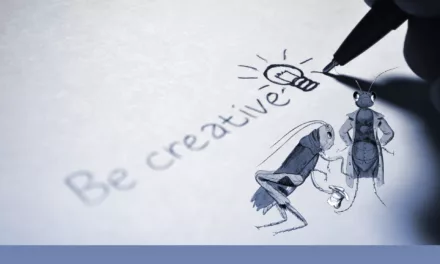
How do you write a good metaphor?

“I struggle with writing metaphors. I can come up with similes easily, but metaphors? Not so much. Any advice?”
If you can write a simile, you’re already halfway there! Seriously. The hard part is making connections between different things, and if it’s something you’ve already mastered, then a metaphor is only one extra step forward. If you already know how to see sadness in the rain, or how to describe someone’s laugh, you’ve started writing imaginatively, and that’s already half the skill.
So why do metaphors feel so much harder? It’s that last leap from “like” to “is” that feels riskier, bolder (maybe even a bit pretentious). “Her eyes were like the ocean” feels safe. “Her eyes were the ocean” feels more exposed. It’s definitive, and therefore easy to question ourselves. What if it doesn’t work? What if it sounds silly?
Metaphors are bolder than similes. That’s exactly what makes them powerful. It’s a willingness to commit to the comparison and make a powerful statement.
Understanding the difference between simile and metaphor
A simile makes a comparison using “like” or “as” (“Her smile was like sunshine”). It draws a figurative comparison, highlighting an imaginative lens through which to view a concept. A metaphor, on the other hand, states that one thing is another (“Her smile was sunshine”). This directness gives metaphors their power; they don’t suggest similarity, they assert identity.
This fundamental difference is why many writers find similes easier. Similes feel safer because they explicitly signal a comparison. Metaphors require more confidence because they make a bolder claim. Understanding this can help you bridge the gap between the two, and also understand when one is more appropriate to use than the other.
When should you use a metaphor instead of a simile?
Use metaphors when you want more intensity and immediacy. They’re ideal for moments requiring strong emotional impact or when you want to eliminate distance between the comparison and the subject. They can also be extended, drawing a direct connection to a subject with multiple layers, rather than a single point of comparison.
Use a simile when you want to maintain some distance, make gentler comparisons, or when the comparison itself needs explanation to work effectively for your readers. Similes are short and simple, so they work well in passing narration.
What makes a good metaphor?
Before you can write good metaphors, you need to recognise what makes them effective. Strong metaphors share several key characteristics:
Clarity
A good metaphor should illuminate rather than obscure. It connects two things in a way that makes both clearer. If your reader has to puzzle out what you mean, the metaphor isn’t working. The connection should feel natural, even if it’s unexpected.
Fresh perspective
The best metaphors surprise us with their originality while still feeling inevitable once we’ve read them. While they can be clichés (“time is money”) they can also offer new ways of seeing familiar things. A fresh metaphor stops readers in their tracks and makes them think.
Emotional impact
Effective metaphors don’t just describe something; they evoke feeling. They tap into sensory experiences and emotional associations. When you write that “his grief was a lead coat,” you’re not just describing grief; you’re making your reader feel its weight.
Consistency
Once you introduce a metaphor, particularly an extended one, it’s essential to maintain its logic. If life is a journey, don’t suddenly shift to treating it as a game without good reason. Mixed metaphors confuse readers and dilute their imagery.
How do you write a good metaphor?
Start with what you know
Start by identifying what you want to describe. What’s the core quality or feeling you’re trying to convey? If you’re describing anxiety, what does it feel like? Is it constricting, racing, overwhelming?
Once you’ve identified that essence, look for something else that shares those qualities. If anxiety makes your chest feel tight, it might be a vice. If it fills your head with noise, it could be a swarm of bees. If it’s overwhelming, it could be quicksand. Each descriptor captures a different aspect of the experience, depending on what you want to convey in a particular scene.
Use sensory associations
Metaphors work best when they engage the senses. What does your subject look like, sound like, feel like, taste like, smell like? These concrete sensory details make abstract concepts tangible.
If you’re describing loneliness, don’t just think about the emotion, think about how it manifests physically. Does it feel like an empty room? A cold wind? An untethered balloon ? The sensory connection makes the metaphor vivid.
Look for unexpected connections
The most memorable metaphors often come from surprising juxtapositions. Try connecting your subject to something from a completely different domain. Describe a business meeting using the imagery of warfare, or a garden using language usually reserved for secrets.
What does the subject remind you of from your own experience? What’s the weirdest thing this could be compared to that still makes sense? Sometimes the most unlikely connections create the most powerful metaphors.
Transform similes into metaphors
If you’re already comfortable with similes, use them as stepping stones. Take a simile you’ve written and remove the “like” or “as.” Then, adjust the language to make the statement work.
“Her anger was like a volcano” becomes “Her anger erupted, spewing molten fury.” You’ve moved from comparison to direct statement, and in the process, you’ve created opportunities to extend the metaphor through related imagery.
Note: a metaphor does not have to use the word “was” to be a metaphor. In the example above, the anger erupting and spewing molten fury makes it clear that the subject’s anger is in direct correlation to a volcano, without having to state it outright.
Common pitfalls to avoid
Clichéd metaphors
Avoid overused comparisons that have lost their impact. “Life is a journey,” “time is money,” “love is a battlefield”—these metaphors have been repeated so often they’ve become invisible. While they can have their place, especially in character dialogue, when it comes to your own narrative voice, they’re best avoided.
Mixing metaphors
When you introduce a metaphor, commit to it. Mixing metaphors (jumping between incompatible images) creates confusion and unintentional humour. For example, “We need to get all our ducks in a row before this ship sails” combines two different metaphors that clash.
If you’re extending a metaphor across multiple sentences, make sure each element belongs to the same conceptual family. Preserve the internal logic of your chosen comparison.
Overextending metaphors
While extended metaphors can be powerful, they can also wear out their welcome. You need to have the self-awareness to know when to let a metaphor go. If you’re having to stretch and contort your comparison to make it fit, then it probably doesn’t.
A good rule of thumb is that if your metaphor starts feeling forced or if you’re spending more energy maintaining the metaphor than advancing your point, it’s gone too far. As always, clarity is the most important thing. If you can’t make your point clearly, then you need to approach it differently.
Being too obscure
Metaphors should illuminate, not mystify. Try to avoid references that are too personal, too niche, or too complex. Your readers need to grasp the comparison quickly, and a metaphor that requires extensive explanation defeats its own purpose.
Writing a good metaphor is less about having a special talent and more about developing your observational skills and willingness to make bold connections. If you’re already comfortable with similes, then the next step is about taking that understanding and making it more direct, more confident, more striking.
































